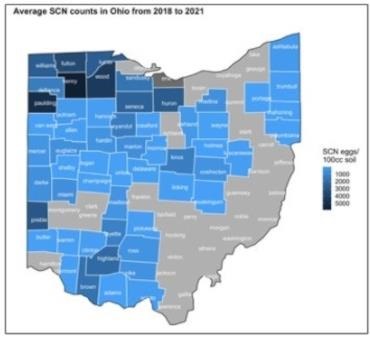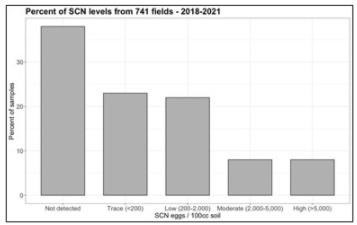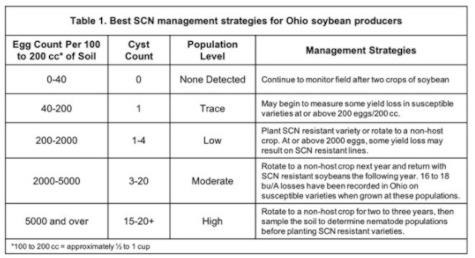By Horacio Lopez-Nicora
One of the main reasons soybean cyst nematode (SCN) remains the most economically important pathogen of soybean is that it can cause yield loss between 15 and 30% with absolutely no visible symptoms. Resistance to SCN remains the most effective management strategy when rotating to a non-host crop is not an option. The predominant source of resistance in most commercially available soybean cultivars comes from Plant Introduction (PI) 88788, which confers resistance to SCN Type 0 (formerly race 3). Soybean varieties labeled ‘SCN-resistant’ most likely have resistance from PI 88788. The use of the same source of resistance over the past 20 years has placed selection pressure on
SCN populations resulting in a shift in virulence, leading to adaption to now infect PI 88788-derived resistant soybean cultivars. In other words, nematodes reproduce at higher levels than before on soybeans developed with PI 88788 resistance.

Figure 1. Mean SCN counts by county in Ohio.
‘What’s your number,’ Ohio? Since 2018, with funding from the soybean check-off through the Ohio Soybean Council and The SCN Coalition, and in collaboration with OSU Extension Educators and growers, we extensively sampled soybean fields in Ohio. To date, a total of 741 soil samples from 57 counties in Ohio were submitted for SCN testing (Fig.1). For most samples, SCN was either not detected (38% of samples) or present in very low numbers (23% of samples with less than 200 eggs/100 cc soil), however, 38% had SCN above 200 eggs/100 cc soil. Some fields (8%) had levels above 5,000 eggs/100 cc soil, which we know can significantly reduce soybean yield (Fig. 2). The number of SCN found in the soil sample will determine the best management plan for that field (Table 1).

Figure 2. Levels of SCN (eggs/100cc soil) in Ohio.
Can SCN populations reproduce on the most commonly used sources of resistance (i.e., Peking [PI 548402], PI 88788, and Hartwig [PI 437654])? Samples with high SCN numbers were used to determine which source of resistance was still effective in limiting SCN reproduction in a greenhouse assay (i.e., SCN Type test). A resistant cultivar will allow less than 10% SCN reproduction compared to a susceptible cultivar. A total of 61 SCN Type tests have been completed so far, each from an SCN population from a single field. Only 10% of these samples were SCN Type 0, for which soybean cultivars with any source of resistance will be effective. More than 85% of these SCN populations in Ohio can reproduce on PI 88788 (SCN Type 2) at levels from 30 to 60% of a susceptible soybean. There are few SCN populations that can reproduce on Peking (SCN Type 1) at very low levels (10 to 30% of susceptible). Hartwig remains highly resistance to our SCN populations, but it is not easy to find soybean cultivars with this source of resistance.
And now what? Soybean cyst nematode is silently gaining territory in Ohio as SCN numbers are rising. The ability to reproduce on soybean cultivars with ‘SCN-resistance’ will lead to an imminent loss in our battle to protect Ohio soybean production. To take action, we need to know our numbers. Managing SCN begins with an adequate and correct soil sample. The SCN Coalition has launched its next phase of raising awareness of SCN distribution and its virulence profile in the U.S. We are excited to continue sampling soybean fields in Ohio to test for SCN with funding from the Ohio Soybean Council and The SCN Coalition. Our goal is to sample more soybean fields, targeting those that have consistently been yielding low, under continuous soybean or double crop, and with weed issues. Fall is a great time to sample for SCN and we are excited to help with this task by processing up to TWO soil samples, per grower, to be tested for SCN, free of charge. For more information on how to sample for SCN and where to send these samples, please visit our sampling article in this issue ‘Collect Fall Soil Samples for SCN.’

Table 1. SCN management
Source : osu.edu